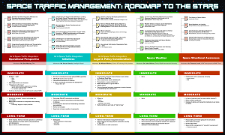Presentation Type
Paper (supporting PowerPoints may be added as Additional Files)
Location
Henderson Welcome Center
Start Date
17-11-2016 3:45 PM
Abstract
Forecasted future demand in space travel is driving the need for the development of space traffic management. Currently, orbital space traffic is mostly unregulated with internationally agreed upon best practices and self-interest driving space operators to avoid collisions with other spacecraft. This paper explores the future of space travel by presenting a concept of creating “airspace in space” or spaceways to manage the ever growing volumes of space traffic. Spaceways are analogous to airspace for aircraft with the goal of increasing levels of safety and reducing probabilities of collision. These goals can be achieved by creating traffic rules, defining valuable orbits and minimum capabilities for spacecraft to be flying in the defined valuable orbits.
The paper will discuss the creation and evolution of airspace for aircraft, provide an explanation for the need of spaceways and discuss a specific concept for defined spaceways in outer space, including some of the disadvantages for creating spaceways. Additionally, airspace is more than managing the flow of air traffic but also a means of nation-states defining the boundaries of their sovereignty. The current legal framework regarding sovereignty in space, arguments for and against a delimitation line between airspace and outer space and the need for international cooperation to define the spaceways will also be discussed. Lastly, further inquiry into liability implications due to the definition of spaceways and potential organizations to create and control the spaceways will be discussed.
Keywords:
Space Traffic Management, STM, Spaceways, Airspace, Orbital, Debris, Space Law, Liability
Area of Interest
Space Situational Awareness
Biographies
Included in
Air and Space Law Commons, Infrastructure Commons, Multi-Vehicle Systems and Air Traffic Control Commons, Science and Technology Law Commons, Science and Technology Policy Commons, Science and Technology Studies Commons, Transportation Commons

Spaceways: Airspace in Outer Space
Henderson Welcome Center
Forecasted future demand in space travel is driving the need for the development of space traffic management. Currently, orbital space traffic is mostly unregulated with internationally agreed upon best practices and self-interest driving space operators to avoid collisions with other spacecraft. This paper explores the future of space travel by presenting a concept of creating “airspace in space” or spaceways to manage the ever growing volumes of space traffic. Spaceways are analogous to airspace for aircraft with the goal of increasing levels of safety and reducing probabilities of collision. These goals can be achieved by creating traffic rules, defining valuable orbits and minimum capabilities for spacecraft to be flying in the defined valuable orbits.
The paper will discuss the creation and evolution of airspace for aircraft, provide an explanation for the need of spaceways and discuss a specific concept for defined spaceways in outer space, including some of the disadvantages for creating spaceways. Additionally, airspace is more than managing the flow of air traffic but also a means of nation-states defining the boundaries of their sovereignty. The current legal framework regarding sovereignty in space, arguments for and against a delimitation line between airspace and outer space and the need for international cooperation to define the spaceways will also be discussed. Lastly, further inquiry into liability implications due to the definition of spaceways and potential organizations to create and control the spaceways will be discussed.
Keywords:
Space Traffic Management, STM, Spaceways, Airspace, Orbital, Debris, Space Law, Liability


Comments
Visit the Research Panel: Governance